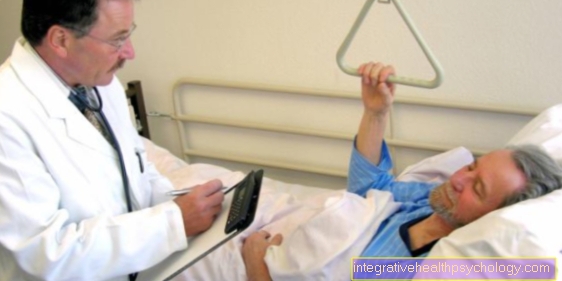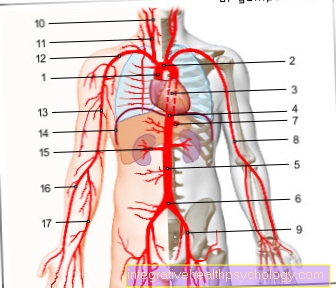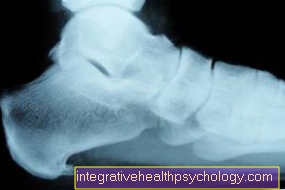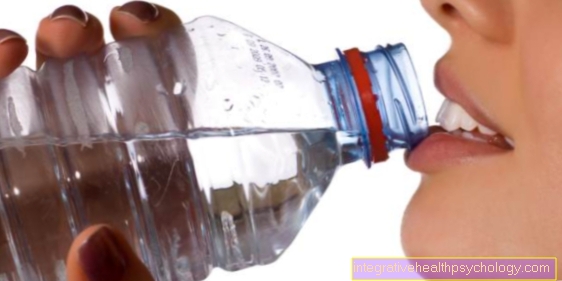Helicobacter pylori breath test
introduction
With the 13C (urea) Helicobacter pylori breath test, the presence of the bacterium Helicobacter pylori in the stomach can be detected with about 99% certainty.
The principle of operation of the breath test is as follows:
Helicobacter pylori has the ability to convert urea into ammonia and carbon dioxide (CO2).
During the test, the test person is given labeled urea mixed with fruit juice. If there is an infection with Helicobacter, the urea is split and CO2 can be detected in the breath.
For general information, we recommend our main page: Helicobacter Pylori - Everything about the topic!
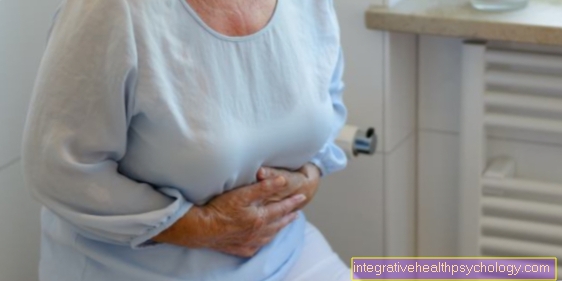
When is the Helicobacter Pylori breath test done?
The Helicobacter breath test is carried out primarily to monitor the success of a confirmed and treated Helicobacter infection. The aim is to investigate whether the bacterium could be completely eliminated with the help of antibiotic therapy (eradication therapy). The costs are usually covered by the health insurance if the eradication therapy was at least four weeks ago.
Read more information on this topic at: Therapy (eradication) of Helicobacter pylori therapy
In addition, the Helicobacter pylori breath test can be used for the first detection of pathogens if, for whatever reason, a gastroscopy is not permitted. This simple test is particularly preferred for children in order to avoid a gastroscopy. Here, too, the health insurance company usually pays the costs.
Otherwise, gastroscopy is the first choice for first pathogen detection.
If no pathogen has yet been detected in you, but a Helicobacter pylori infection is suspected, you will probably have a gastroscopy. Read more about this at: Gastroscopy - What Are the Risks?
When should the Helicobacter pylori breath test be repeated?
If you have been diagnosed with Helicobacter pylori infection, e.g. a gastroscopy and tissue removal, and you have then received drug therapy, the breath test can also be carried out several times to check the success of the therapy.
Also read: Therapy of Helicobacter pylori infection
If the breath test suggests that the Helicobacter has been eliminated, but symptoms return after weeks or months, you should repeat the breath test. This then helps to assess whether the drug therapy was really sufficient or needs to be treated again.
We also recommend our site to: Symptoms of Helicobacter Pylori Infection
How is the breath test done?
Before the test is carried out, a so-called basal value is taken. This means that the person concerned exhales into a bag until it is no longer possible. The values obtained here serve as a comparison later.
The patient then swallows urea, which is marked with the 13C isotope. 75mg of this is usually dissolved in 200ml orange juice.
After drinking the solution, the patient must wait 30 minutes and then exhale into a bag again. If there is an infection with Helicobacter pylori, the bacterium breaks down the urea. Among other things, this creates labeled carbon dioxide, which can then be detected in the air we breathe.
Can you do this at home or is it only possible at the doctor's?
The Helicobacter Pylori breath test is too complex to be carried out independently at home. That would lead to wrong results. Since the fruit juice can also cause allergic reactions in rare cases, the test is always carried out by a doctor.
Do you have to prepare for the Helicobacter breath test?
It is particularly important to note that you come to the breath test on an empty stomach.
This means that you should only consume light food on the evening of the day before and not drink any carbonated drinks. At least six hours before the examination, food, drinks and cigarettes must be completely avoided in order not to falsify the test.
If you are taking antibiotics, they must be stopped about four weeks in advance. Do you take proton pump inhibitors, such as Pantoprazole or omeprazole, you should not take them two weeks beforehand. Otherwise the breath test would be falsely negative or falsified with great probability.
How is the breath test evaluated?
If there is a Helicobacter Pylori infection, 13CO2 is exhaled and can be measured using special methods. If there is no infestation with the bacterium, only normal exhaled air is found.
Does therapy always have to be given if the evaluation is positive?
It is important to note that an infection with the bacterium does not allow the detection of a disease at the same time.
Many healthy people are also carriers of Helicobacter pylori without showing symptoms of Helicobacter pylori infection. If the involvement of the stomach is detected, this is not enough for a possible therapy planning, but further diagnostics must be carried out to detect ulcers or cancer.
Find out more about the therapy of the Helicobater Pyloris at: Eradication of the Helicobacter pyloris
Can the rapid test also be false positive?
The Helicobacter Pylori breath test has always performed well in clinical studies.
It recognizes 100% of healthy people as healthy and shows a negative test result for them.
This means that if you do not have a negative test result, but a positive one, then you are most likely infected with Helicobacter pylori. The infection can thus be confirmed.
Also read: Symptoms of Helicobacter Pylori Infection
How long does it take to get the result?
The breath test itself only takes about 30-40 minutes.
The measured samples from the breath are sent in for analysis. The result of the analysis is then available after about two to three days.
What are the costs for the Helicobacter Pylori breath test?
If the Helicobacter Pylori breath test is carried out as part of a therapy process or for the first detection of pathogens in children, the health insurance usually pays the costs.
In adults, a gastroscopy is always the first choice for the initial diagnosis of a Helicobacter pylori infection. This means: If you as an adult do not want a gastroscopy or if this cannot be carried out on you as part of an initial pathogen detection, you probably have to bear the costs yourself.
However, private health insurers usually cover the costs. Otherwise the costs are around 15 to 20 euros.
Alternative to the breath test - the urease test
The urease rapid test is another way of detecting Helicobacter pylori. However, this test can only be carried out if tissue samples have been obtained from the gastric mucosa. A gastroscopy always precedes the urease rapid test.
As with the breath test, the functional principle of the rapid test is based on the ability of Helicobacter pyloris to convert urea into carbon dioxide and ammonia.
The test strip of the urease test contains a urea-containing color indicator. If the Helicobacter is contained in the tissue sample, the urea is split. The ammonia that is created increases the pH. The test strip reacts to a change in the pH value by turning red.
If the color does not change and the test strip remains yellow, there is no Helicobacter pylori.
Read more on this topic at: The rapid urease test.
When does a rapid urease test make no sense?
The urease rapid test is metabolic-dependent, so it can be falsified by the action of certain substances: If therapeutic agents are taken - such as proton pump inhibitors (e.g. omeprazole, pantoprazole) or antibiotics - the activity of urease is inhibited. The Helicobacter Pylori cannot produce ammonia. It can no longer protect itself against gastric acid.
This also makes sense, because the aim is to eliminate Helicobacter pylori with the help of the medication.
However, since the functional principle of the urease test is based on the detection of urease activity, it is assumed in such a case that no urease and therefore no Helicobacter pylori is present. Thus the test result is false negative, it is falsified.
In order not to influence the test, antibiotics should be discontinued six weeks beforehand and PPIs one week beforehand. Otherwise the test makes no sense as the results will be unreliable!
Can I buy a rapid urease test from the pharmacy without a prescription?
No. In order to carry out the urease rapid test, a tissue sample from the gastric mucosa is required.
This tissue sample can be obtained through a gastroscopy. It is therefore an invasive, intrusive procedure necessary to perform the test. This is of course carried out by the doctor. Therefore, it makes no sense that the urease rapid test is issued in the pharmacy without a prescription.








